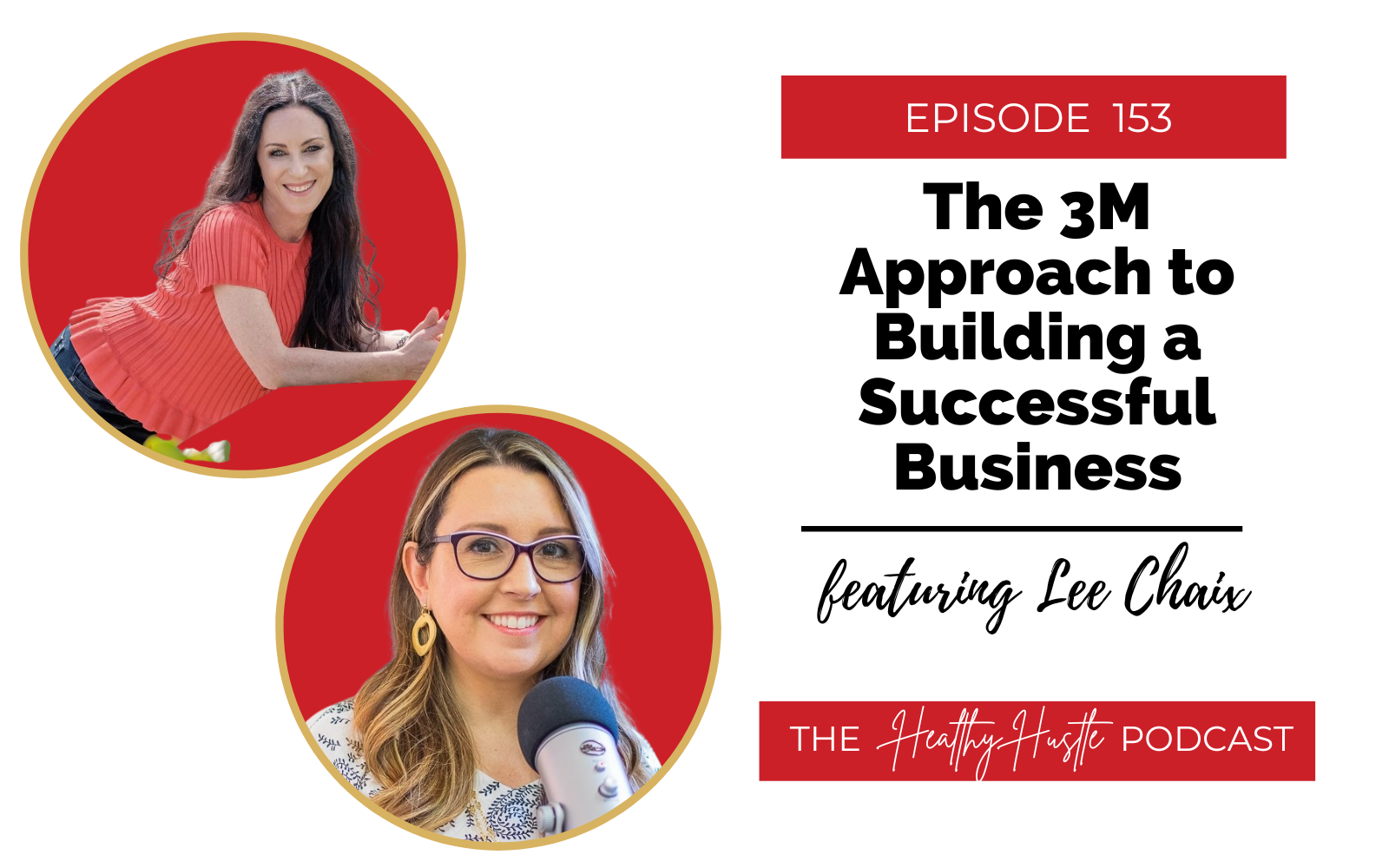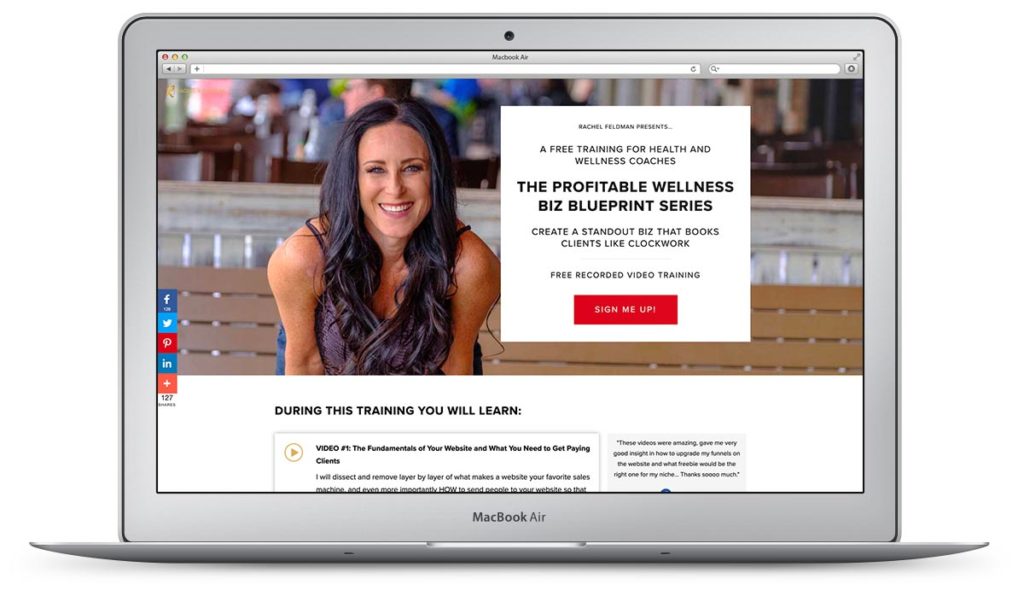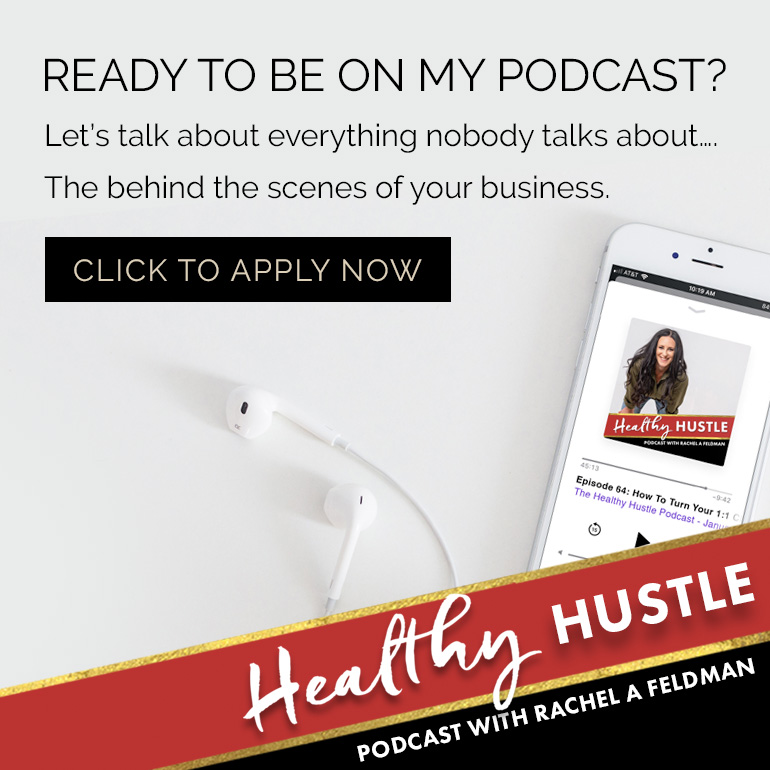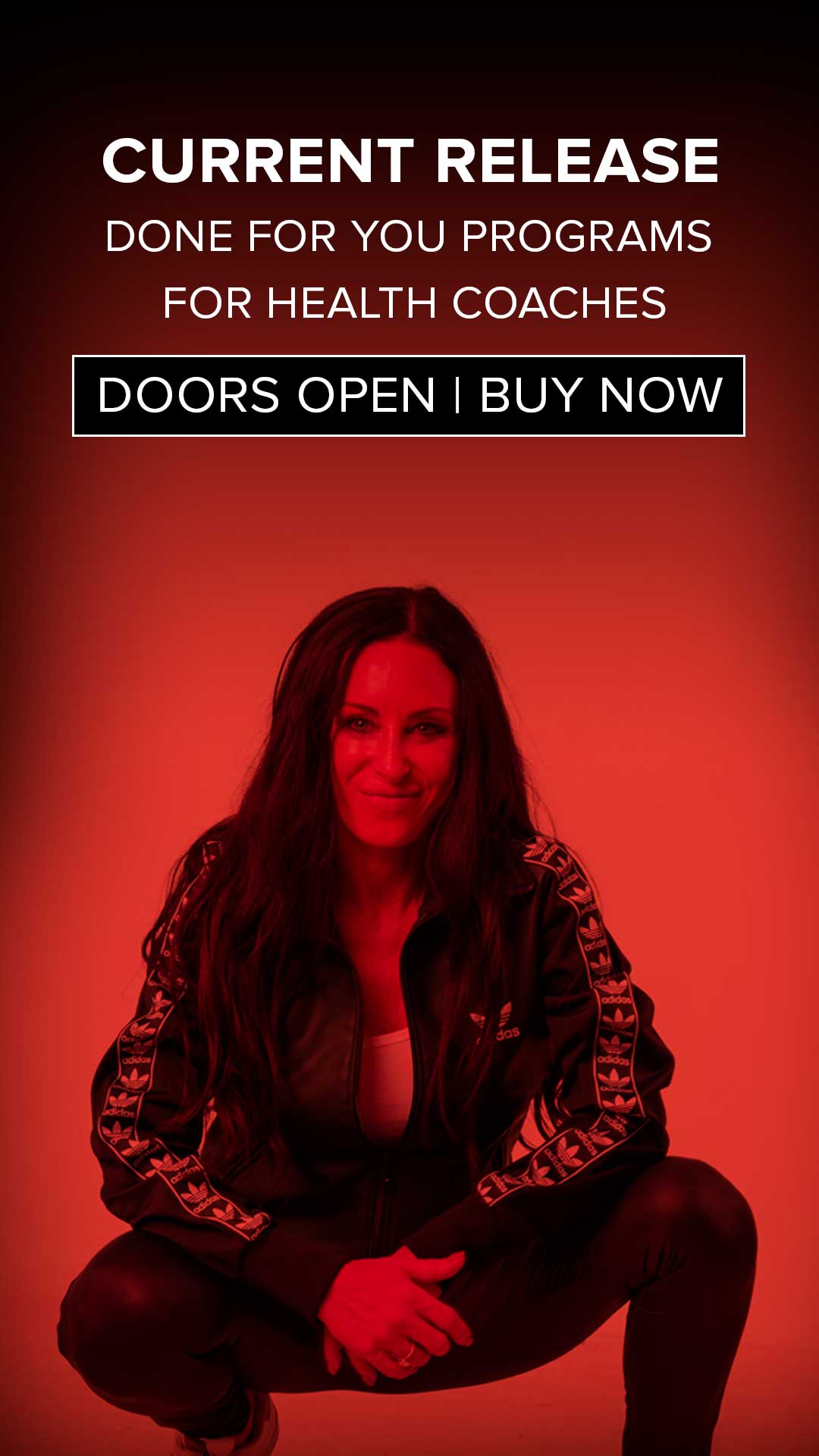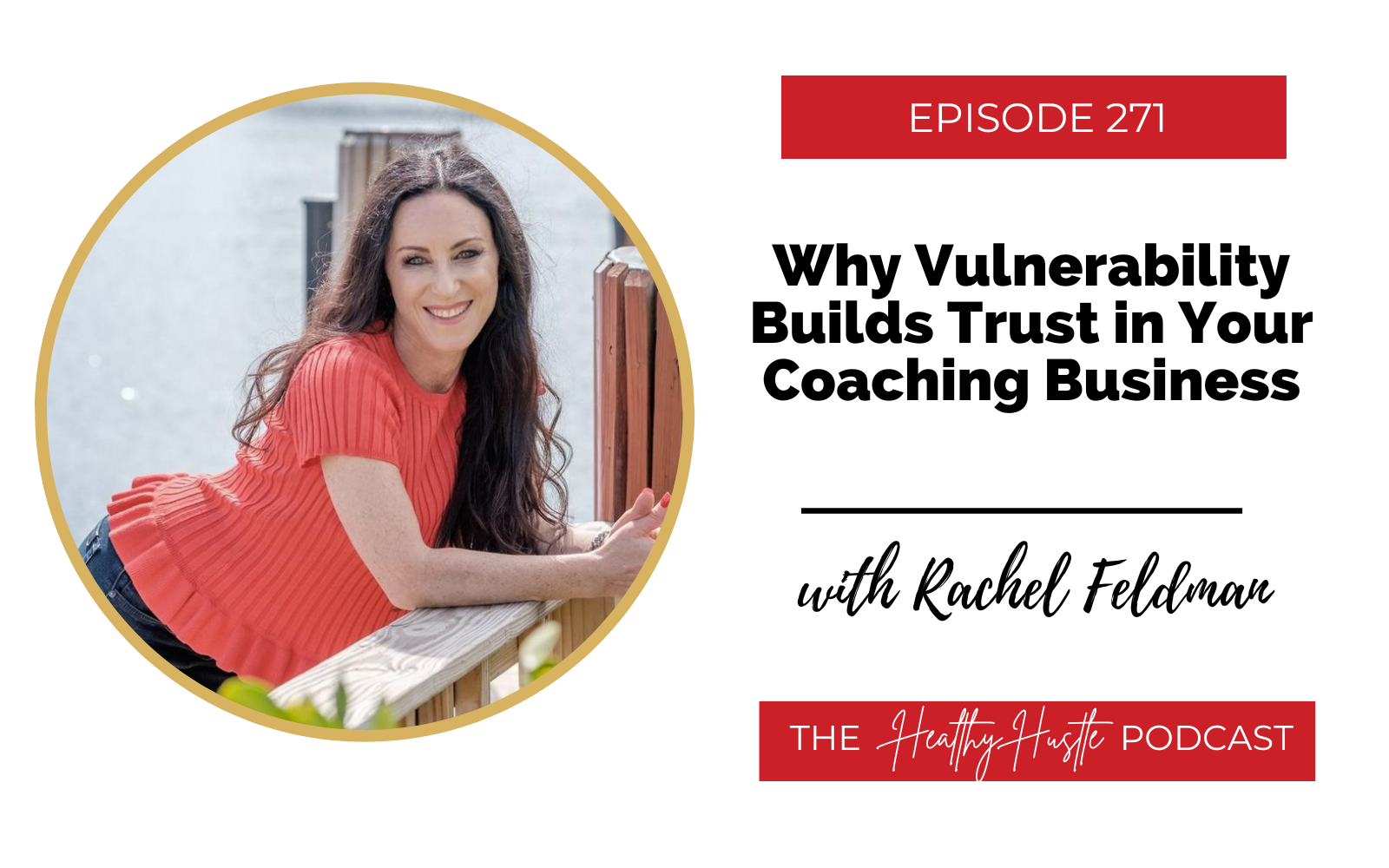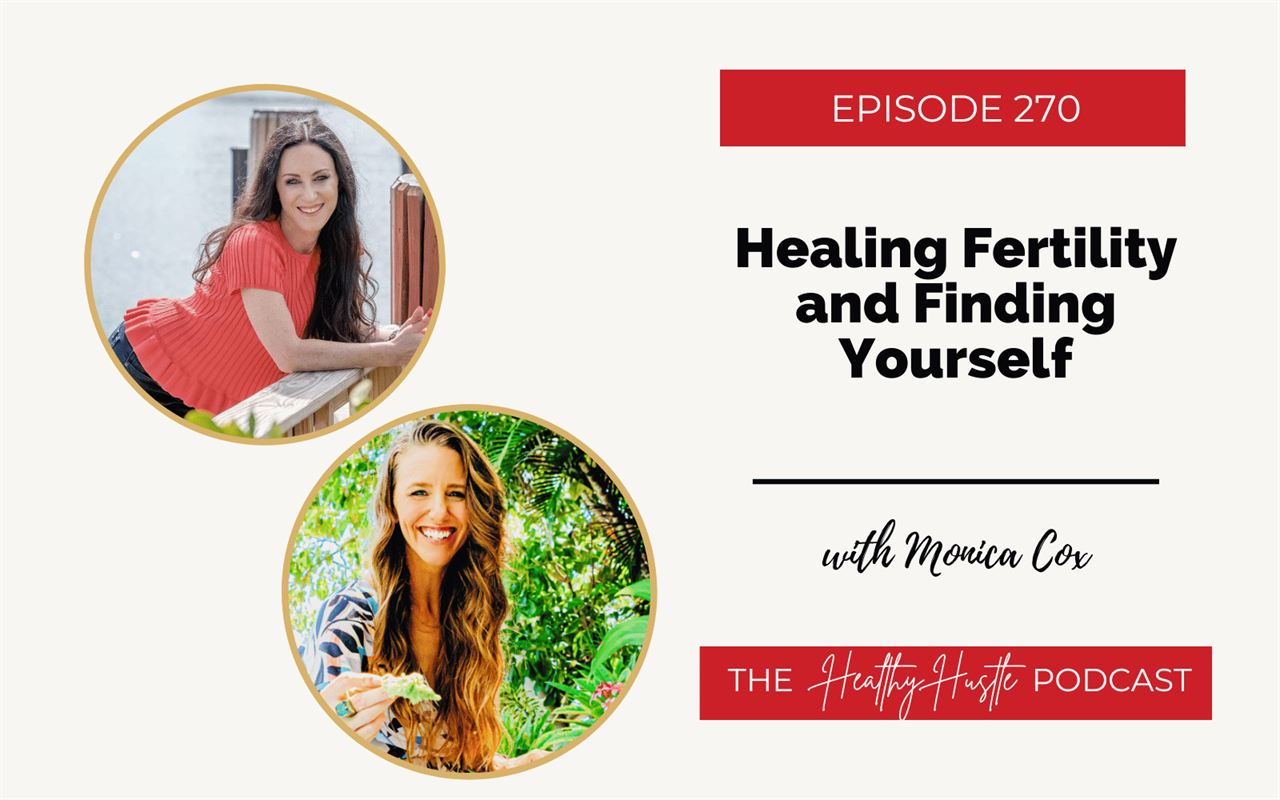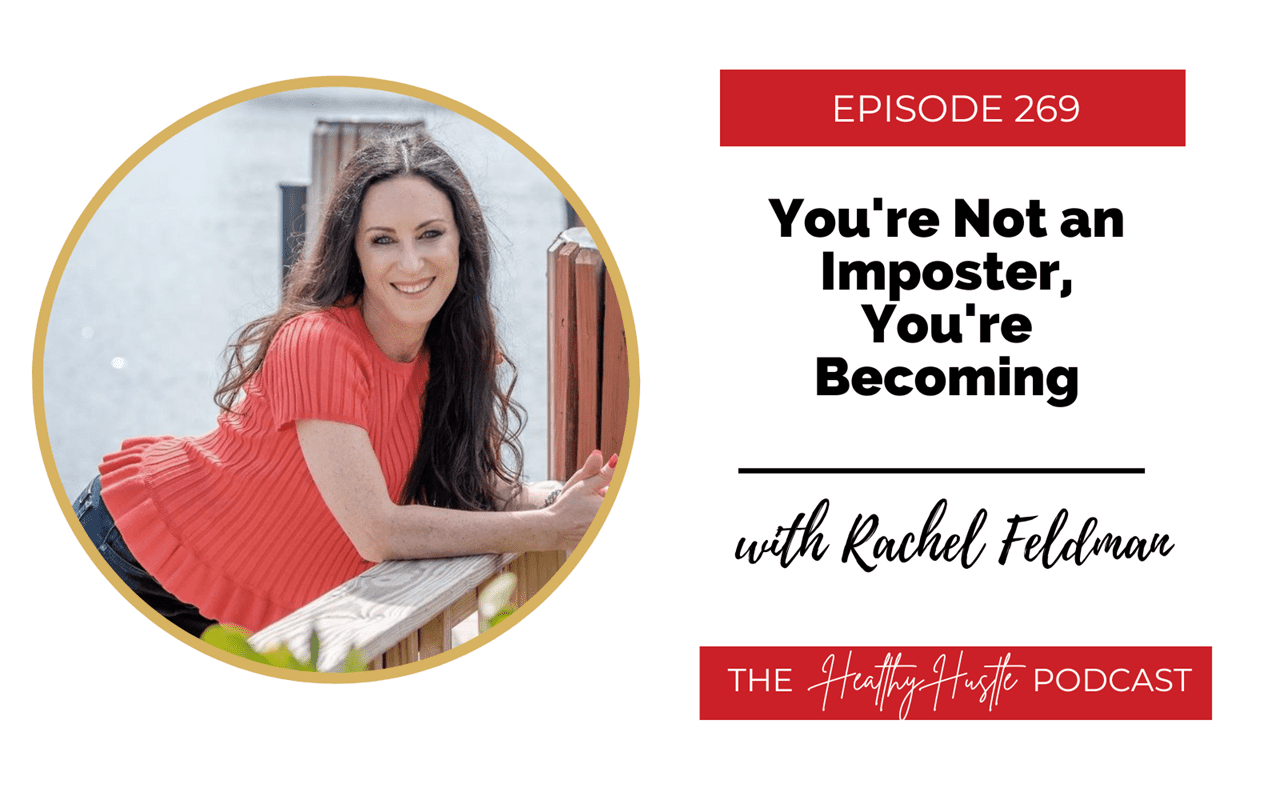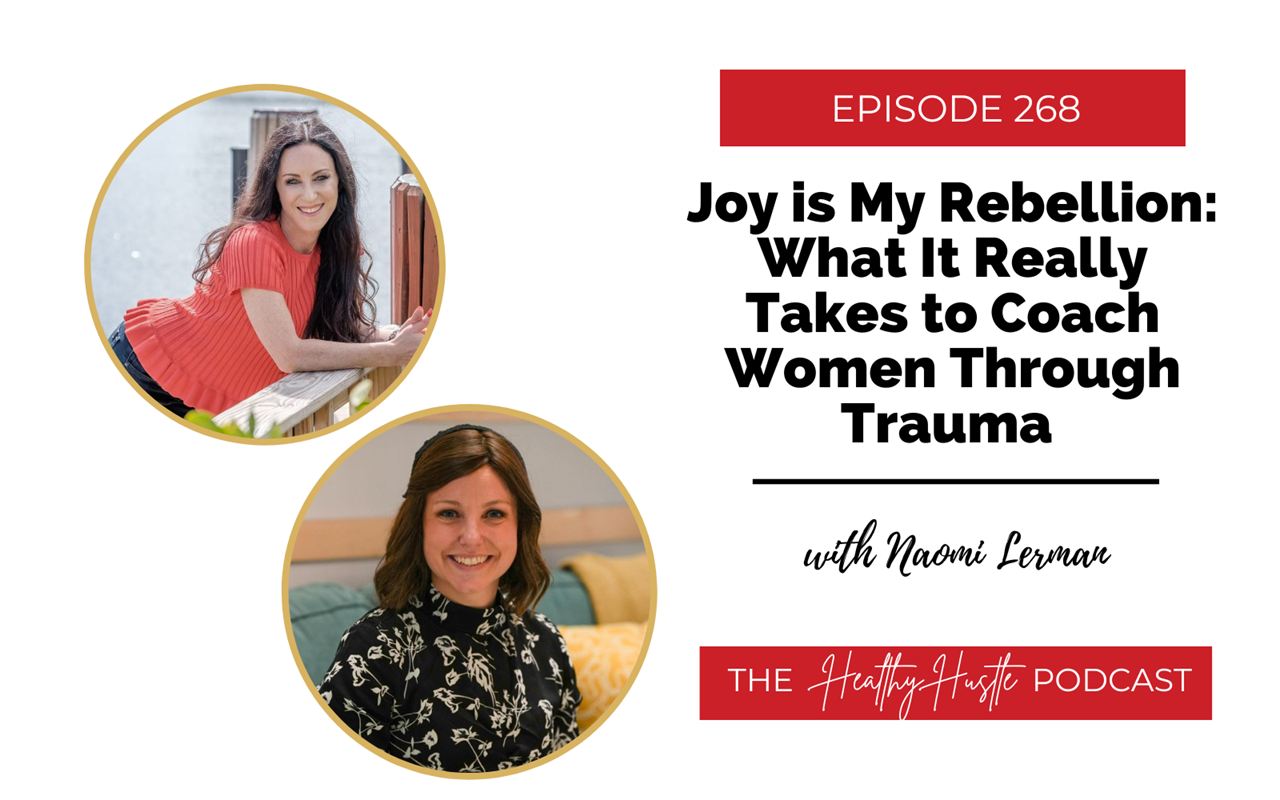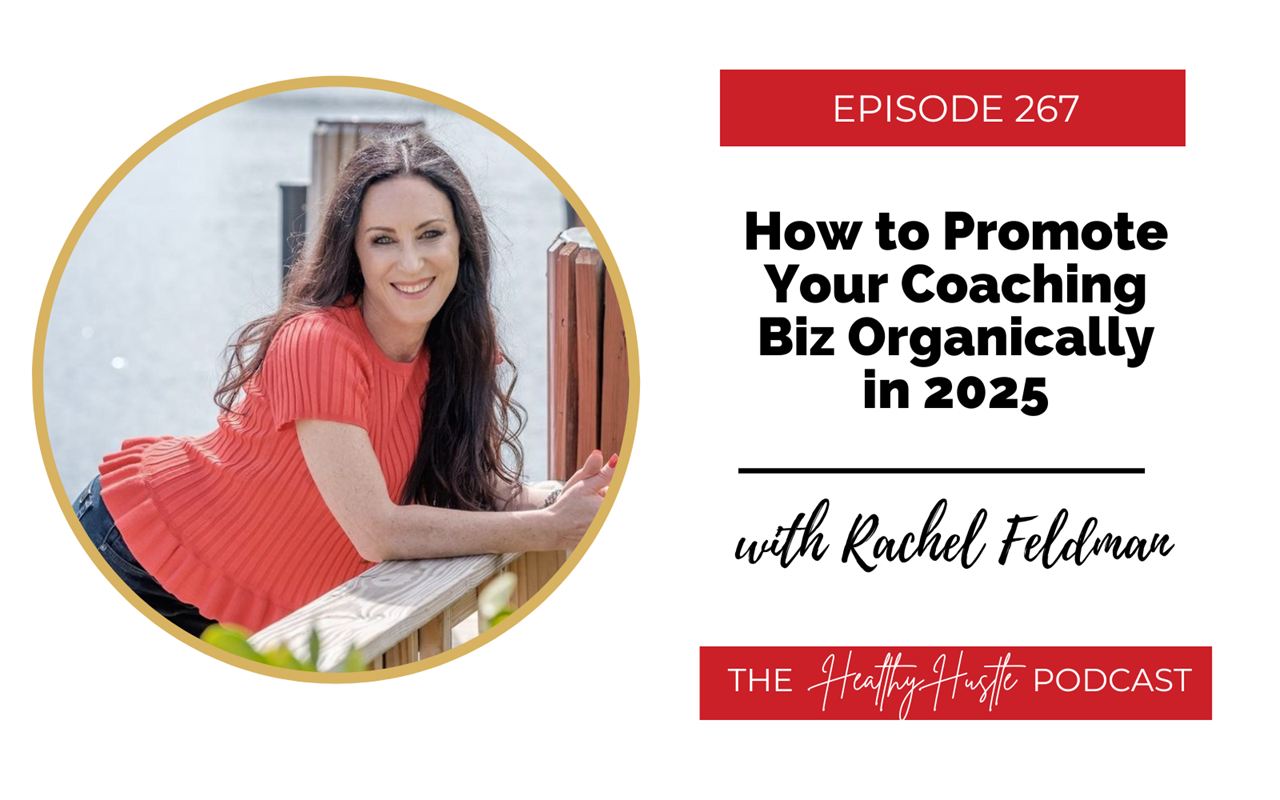There isn’t a health coach out there that isn’t dying to have a successful and thriving business. But what characteristics do you need to build a profitable and fulfilling health coaching business? If we ask today’s Healthy Hustle guest (which I most certainly did), she would say Mindfulness, Meaning, and Mindset – which is her signature 3M approach to life and business.
Want to learn more about the 3M Approach to building a thriving coaching business? I thought so!
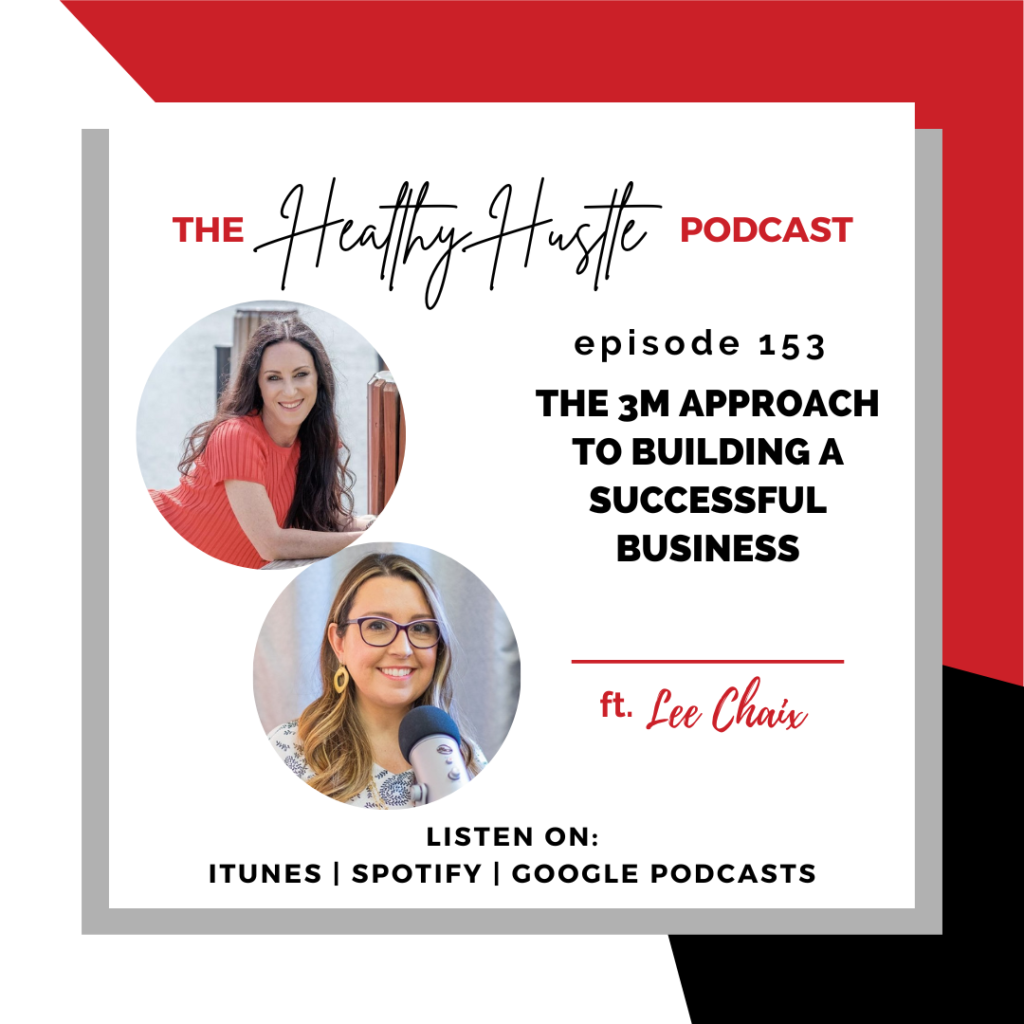
My incredible guest, Lee Chaix is an author, podcast host, and founder of Coach with Clarity, where she supports intuitive, innovative coaches as they deepen their coaching mastery and build sustainable, profitable coaching businesses. During our conversation, Lee unpacks her 3M approach to business, the characteristics of a successful coach, how we can all be more mindful and present in the moment, and so much more!
Connect with Lee:
Website: https://www.coachwithclarity.com
Free Chapter of the ACT On Your Business Book: https://www.coachwithclarity.com/act
Coach with Clarity Podcast: https://www.coachwithclarity.com/podcast/
Rachel: Hey guys, I’m so excited here to be with my good friend Lee because we’re gonna be diving into this really cool framework called the 3 M. So I told her right away, we have to talk about this because there’s not a coach out there who isn’t dying to know how to have a successful and thriving business.
Lee, thanks so much for being here. Can you tell everyone a little about you?
Lee: Absolutely. Rachel, thank you so much for having me. So my name is Lee Chaix McDonough. I am the founder of Coach with Clarity, where we support intuitive, innovative coaches as they deepen their coaching mastery and build sustainable, profitable coaching businesses. So we do that through a full-on certification program that is accredited by the International Coaching Federation. And then we also have a group coaching program, where we really dive into what it takes to be a successful fulfilled coach.
Rachel: Well, I heard the word profitable. And the biggest question I think that every coach has hearing all this information is how do I actually implement and build this practice that is going to fulfill me and not burn me out and make me really happy? So that’s why I wanted you to dive into the characteristics of a coach building this profitable business?
The Characteristics Of A Coach Who Builds A Profitable Business
Lee: Well, the number one, and this actually contributes to the sense of overwhelm that we feel around Wait, how do I actually do this? The number one trait is that coaches tend to be big picture visionary thinkers. They are really able to spot opportunities both in their clients lives and what their clients are working through, but also for themselves. And that is such an essential quality for being a really powerful coach.
But every strength has a shadow side, which is that when we are able to create these big visions of what’s possible, it’s almost as if we feel like it’s inevitable, this is going to happen, I can make this work. But then we look at that ideal future. And we look at where we are today. And then there’s this huge chasm between those two points. And that’s where we can start to feel overwhelmed. We can see the big picture, but we don’t necessarily see the step by step roadmap for getting there.
So that’s where it’s helpful to say, Okay, I know I’m feeling this way, it’s actually a sign that I’m a visionary thinker. Let’s really drill down and create the steps and processes that will help me achieve that vision. And that’s also something that powerful coaches can do. And that’s why I believe every coach needs a coach because we all benefit from that level of support, when it comes to taking action.
Rachel: Oh, definitely. In the beginning stages of my career, I hired five coaches back to back, because some coaches just had that personality that I wanted. Or I wanted to be authentic when I was showing up, I wanted to push down that ego that says no don’t be that vulnerable people can actually know you.
What Powerhouses Visualize & How They Pivot When Necessary
But one of the things that really resonated with me that you were talking about, is that really big picture coach sees what they want, that blueprint and that roadmap. And I know you must teach that in your cabinet coaching. But would you say that the powerhouse coaches are the ones that see the roadmap, but know that it’s going to pivot?
Lee: Absolutely. I love having a roadmap. I love partnering with my clients to create one. But we want to make sure that we are building in flexibility as we go. I think the best plan is an adaptable one. Because things change. Sometimes it’s external circumstances that change and force us to pivot a bit. But sometimes we change. In fact, often we change.
As we do the work, as we get to know ourselves better. As coaches and business owners, we may realize that certain tactics work better for us than others. Maybe we become more deeply connected with our values and we want to modify how we’re showing up in the world to really fully express what matters most to us.
So I think anytime we’re creating action plans, when we can bake in flexibility, adaptability, and also time to review the plan. It’s one thing to have a great plan and to implement it. But we want to make sure that every three months, six months, however often works for you. We really are pausing to make sure: Am I still on the right track? Are there any modifications that need to be made?
The 3M Approach To Life & Business
Rachel: I’m sure this flows right into your 3M approach, so why don’t you just tell everyone about it? Let’s dive into what it is because you wrote a book about this. These are the really cornerstone pillars of your business and your thought behind your business.
Lee: Absolutely. So I wrote a book called Act On Your Business, Braving The Storms Of Entrepreneurship and Creating Success Through Meaning, Mindset and Mindfulness. So spoiler alert, those are the three M’s. And for me, those are the pillars to creating a fulfilling, successful coaching practice, but really a fulfilling life.
When we are grounding our thoughts, our behaviors, our actions in the three M’s, we are just going to experience a greater level of contentment.
Rachel: So maybe let’s walk through each one of those three M’s a bit.
The Importance Of Meaning
Lee: So the first M that I talked about is Meaning. And this is really getting clear on what matters most to you. What do you want your legacy to be about? What do you want to be known for? And when we’re looking at meaning, there’s really two parts to that. Number one, we want to be clear on what that actually looks like, what are our core values? But then number two is how do we take action in our businesses in our relationships in our lives, that is aligned with those values, because it’s one thing to say, this matters to me, it’s another to really put your money where your mouth is, and do it.
So in our coaching businesses, when we understand what our professional values are, our business values, they become the barometer by which we can then decide, okay, are these actions in alignment with how I want to show up in my business? So that’s the first step.
Rachel: I think a lot of us don’t pause in that beginning, because that overwhelm steps up. And we just tried to dip through to chapter 25, instead of starting at chapter one and saying, What do I want to be known for what’s really important to me? Why does my work matter? And build up that self worth in that confidence?
Lee: That’s right, because when we face the tough moments in our businesses, and we will that is inevitable, yes, we’re gonna have hiccups, we’re gonna have depths, when we can go back and re anchor into our values and remind ourselves, this is why I’m doing this. This is why it matters to me, it helps us navigate the overwhelm and the discomfort that comes when we go through a rough patch. So that’s why I think starting with that first M of meaning can be so helpful. It really supports us as we take action.
Rachel: So when you’re writing your mission statement. That’s when you’re writing your why. That’s when you’re getting clear on your niche, beginning with, what do I want to be known for? What am I contributing to this world? It gives me chills even saying that, because that was the only thing that ever made me face my fears. And we all have fears in this business, different ones, but forced me to go right on video, because I was like, I have to get this message out. Otherwise, I would have just sat there and done a lot of busy work like I see a lot of coaches do, buy more courses, more courses, more courses, instead of sitting down in that beginning stop, which I do think is the foundation, just as you mentioned.
Lee: Absolutely. And I will be perfectly honest with you. Part of the reason I wrote this book was because I didn’t have a guide like this when I started out. When I started out, I did not anchor my business in my meaning, in my core values. I was moving away from a very successful career as a psychotherapist. I had this gut sense that I’ve got to make this work. If I’m turning my back on my career as a therapist, then this coaching thing, it better be worth it.
So what I did, unfortunately, is I anchored my work around what I thought other people would want, and what I thought other people would pay for. So I created this coaching brand, and this identity with visual imagery and so forth that didn’t look like me at all. It didn’t reflect who I was, or how I wanted to build that connection
Rachel: And it all felt stagnant in our business and our life.
Lee: Yes, I felt completely lost inside my business for over a year. And it was because I didn’t lead with who I was and what makes me special and unique. I didn’t lead with my values. So I really had to course correct a good year or so into my business. And the minute that I got clear on why am I doing this work? Why does it matter to me? How does it connect with the things that I believe in and that I stand for?
Then I was able to create a business and a brand that was fully in alignment. And that’s also when I started to attract more clients. And we’ve talked a lot about finding clients and how that works. And I’ve learned that you can’t be afraid to turn the wrong people off in order to turn the right people on and part of the way we turn the right people on for that moment.
Again, a little boom, Mic drop. But it’s true. Because when we’re clear about what we stand for, and what we believe, the people who resonate with that they’re going to feel instantly connected to us, they’re going to want to learn more about us. And so we can’t be afraid to draw some, some of the naysayers. They’re not our people. And so if anything, it’s just like, Okay, now I know that’s not where I need to place my focus. Let me really focus on the people who need to hear my message from me.
Rache: I appreciate you going back because now we can jump forward because maybe we haven’t focused enough on what that beginning means on how powerful it is, and how essential it is because you can’t build a profitable business by not having those things in order.
Lee: Now, it may be short-term profitable, but I don’t think it’ll be sustainable and start to affect your life too. Because when we are holistic entrepreneurs, there really is no separation. There’s not. At least my business doesn’t exist in a vacuum. It’s very connected to all of me, and I want it to be that way. I’m happy with that. But then I have to understand how all of these pieces weave together. And so that meaning M really helps me do that.
Rachel: Okay, so now let’s jump into the next part.
The Importance Of Mindset
Lee: Yeah, so let’s talk about M number two, which is mindset. And this is an M that I’m sure many coaches are familiar with. It is a big one. It’s absolutely a big one.
So I want to be clear that when I’m talking about mindset, I’m really talking about our internal relationship with our private experiences. So those private experiences – our thoughts, feelings, sensations, emotions, memories, things that we know are happening within us that someone else might not know, unless we told them, hey, I’m thinking this or feeling this.
And so the way that we relate to those private inner experiences that fall under the larger umbrella of mindset for me, so it certainly includes thought work, it certainly includes the mind. But it can also include emotions and those other things as well. What I find is that when we have an unwanted or distressing thought like, I’m no good, people are going to judge me, I’m never going to make it like all of that inner critic stuff. Our default tendency, I should say, is to latch onto it. And to believe it is truth, because our mind has said so.
It’s funny, because I find sometimes it’s the opposite with unwanted emotions. If we experience an uncomfortable emotion, we don’t want to feel that. And so we’re going to push it away, we’re going to avoid, we’re going to find other things to distract us from that. Sometimes not very healthy ones. And so we glom on to these thoughts, and we push away these emotions. And then we just get ourselves in a state of feeling overwhelmed and lost and alone.
Rachel: I just did a tech talk before we started and I was talking about this overwhelm that comes in, that burnout, and that often the biggest thing is the fear. It’s not all the work. It’s not the launching, it’s not doing the webinars or running a challenge is scary. But it’s the inner thoughts that’s really exhausting and drain us.
Lee: Well, and it’s because it’s universal, right? I definitely want to normalize these types of thoughts and feelings, because we’re human, and it’s going to happen. Actually, there’s a really good reason why it happens. I like to think of our mind as the ultimate safety monitor. It wants to keep us safe at all costs. It’s why we survived as human beings. And it’s going to do whatever it takes to keep us safe. And a lot of times, as our visibility increases, our vulnerability does too. And when we’re vulnerable, the mind doesn’t like that.
So it’s going to come in and it’s going to speak crap. It’s going to challenge you, it’s going to speak rather unkindly, and say, “Who do you think you are to do this” You’re gonna get shamed, you’re gonna get canceled, nobody’s going to believe you all of these things. Because if we believe that, then we retreat, and we go back to where it’s safe, and where it’s small.
So it’s helpful for me to think about the mind as trying to do a good job, trying to support me trying to keep me safe. When I think about it in those terms, then I put myself in the power position of getting to choose, do I need my mind to be keeping me safe right now? Is safety my priority? Sometimes it may be, but more often than not in my business, what I need is not to be safe. What I need is to put myself out there and be encouraged. So when I understand why my mind is pumping me with all of these thoughts, then I can respond in a way that’s going to serve me best in the moment.
Rachel: Well, you just explained that so beautifully. The mindset part and how our brain functions –I think a lot of people think that those who are successful don’t have those fears or don’t have that impostor syndrome. But it’s just that we don’t sit there for very long. We all have them. It’s just how long you sit there.
Lee: That’s exactly right. My goal with my clients, but also in my own self coaching, is not about getting rid of unwanted thoughts or emotions, or banishing impostor syndrome, or any of that, I think, if our goal is to eliminate something, we’re setting ourselves up for failure.
Rachel: But to your point, what we can control is the amount of time that we spend experiencing these things. If we can shorten the duration, so that we can get back to doing that value- based work, that gives us a sense of meaning and purpose, then that’s what helps us navigate a tricky situation. That’s what helps us ground, coming back to that. What is this special work that I’m actually doing? And why does the world need to hear it?
Lee: Exactly. So we’re already seeing how interconnected the three M’s are, we haven’t even talked about the third one yet. But they’re all woven together like a tapestry. We can talk about each one of them individually. But it helps to see how they all work together to support a really healthy, holistic approach to this work.
Rachel: And so let’s dive into the last time.
The Importance Of Mindfulness
Lee: Yes, so the last M is Mindfulness. I for one am very excited that mindfulness has really hit the zeitgeist over the last 10 years. It’s very trendy, yes. But because it’s so trendy, sometimes people hear it and there’s an immediate eye roll.
So let’s just clarify what we’re talking about first. Mindfulness is simply the act of being fully present in the moment you are in, preferably from a perspective of openness and curiosity and nonjudgment, and really being fully tuned in to whatever’s going on in the here and now.
And that is challenging. It’s why we talk about having a mindfulness practice, because it requires practice, these are skills that we can develop. What I find most often is that when we are getting pulled away by our thoughts or emotions, there’s that mindset piece. We tend to, I call it time traveling. We either think about what we could have done differently, could have done better, we replay things that have already happened. So we’re living in the past, or we’re jettisoning ourselves into the future, worrying about what hasn’t happened yet trying to play and trying to prepare. And we have pulled ourselves right out of the present moment.
I want to be clear that I think it is important to plan and prepare, being future oriented can be very helpful. We can also learn from the past and allow that past learning to inform our present. But that should be an intentional decision to reflect on the past or to plan for the future, not a default response. So mindfulness practice helps us then ground ourselves in the present moment, to be fully connected to the people we’re speaking to, to the people we’re loving, to ourselves. So for me that is at the heart of mindfulness, and it’s where we can experience true contentment.
What Happens When Coaches Don’t Sit In Their Mindfulness
Rachel: What would be a great example of a coach that is not sitting in their mindfulness? What can a coach experience when they are practicing? When they’re not in their mind?
Lee: Oh, my goodness, well, this is the proverbial rat race. This is just taking action for the sake of taking action. It’s that kind of busy work that so many coaches fall into. We’re worrying about is this enough? Am I going to get clients? It just goes on and on and on. It really pulls us into that spiral of feeling overwhelmed, anxious, and it can lead to burnout, as well. And it’s why mindfulness practice is often used when we are working with people who are experiencing burnout, because it helps us re attune and re acclimate ourselves to the present moment.
Rachel: I love that you shared about that. I’ve been sharing very openly that I went through one of the worst burnouts and I had to really look at what was going on in my life. What was going on in past trauma, what was going on in my life’s experiences because it’s odd, me overworking and feeling that I needed to be nonstop to be successful. And that was the core belief that had been with me for the longest time.
And as I really stood in and stepped into that truth of like, how I’m not present? Being conscious of every time I picked up my phone if I was at a family event, that kind of stuff that just takes us out and we’re like, oh no. I’m checking work. But to really stop those behaviors, step into that mindfulness practice. And really ask yourself, what’s pulling me away from being present in the moment? I think that was a biggie for me.
Lee: Yes, that’s huge. And that does require a willingness to be vulnerable with the self. It requires introspection and self reflection, which I think many coaches are naturally good at. And we understand how to guide our clients through that as well.
I want to say that you can be a mindful coach and a hard worker. You can be a mindful coach and really love taking action in your business. For me, mindfulness is very much connected to intentionality. Am I working in order to escape? Am I working in order to soothe my anxiety? Or am I working because it brings me joy? I know I’m always on the right track, when I feel like I’m in a flow state when I’m working in my business, because for me, flow and mindfulness are inextricably linked. And that feels very different, both emotionally but also somatically. In the body, it feels different to be operating from that state, versus the rushed, hustle, anxiety driven, I gotta get this done, or else, that’s an entirely different approach. And so it’s not that we can’t work and work hard. But it’s the intention behind it. That’s different.
Rachel: I love that. I think for that new coach, especially building their business, there is so much overwhelm.
Lee: We talked about the roadmap, we talked about the mindset, we talked about grounding in the meaning. And I feel like this last part is really the bread and butter of the successful business. Because if you don’t marry this last part with each of these other ones, it’s really hard not to then go into burnout. And it’s really hard not to step into the massive overwhelm.
Where To Start Showing Up Externally and Internally
Rachel: Well, just for the coach who is having a hard time, showing up and having that vulnerability, what would you say is a good place for that person to start?
Lee: The very first place to start is from the perspective of grace and self compassion, understanding that you’re experiencing this not because there’s a problem or a flaw with you. This is how we are wired, we are hardwired for this. So there is nothing wrong with you, you’re not doing anything wrong, it may just point to some skills that need some strengthening. So that, yeah, that’s all it is, I never want people to feel shamed, or like they’ve done something wrong, or that they are someone wrong. This is a normal response to stress.
Instead of shaming ourselves or making ourselves feel bad, let’s just create a space where it’s like, Okay, I am having these thoughts, I am having these feelings, that this is a cycle, a phase perhaps.
So we want to start with really just treating ourselves with compassion and with grace. And then once we’ve normalized that, then we can start diving into, okay, why am I doing this work? Why is this important?
Rachel: We go to that Meaning pillar.
Lee: Exactly. So we start from self compassion and grace. I will say as a former therapist, who now coaches, sometimes the lines between therapy and coaching can get a little blurry. If you’re finding it particularly difficult to treat yourself with with compassion and grace, if the thoughts continue to come to the point where they’re almost intrusive, if these habits are such that it’s so hard to break, that it’s interfering with your ability to move forward, then you may need some support in even this first step. And that’s where a really good therapist can come in.
But many of us are able to kind of self coach our way through this. So if you’re able to create that space of compassion, then we can reconnect with the meaning pillar. That gives your life a sense of purpose, what drives you. And then from there, we can take values driven action.
Rachel: I love that you keep talking about rewiring the brain. We’re actually working on a program to sell that’s about rewiring the brain. I’m not gonna get into the science part because that’s a whole nother episode. But talking about how this our brain really does try to protect herself and how to create these different practices and habits that get us to kind of rewire our thought patterns.
Lee: Yes and in a very practical sense, I have never met anyone for whom being told not to think something or not to feel something has worked when it’s like, oh, don’t worry about that or don’t be sad, that doesn’t work. If anything, it just heightens that thought or that feeling.
So instead of trying to avoid or minimize it, if we can just create space for it and meet it head on. I recognize that, especially with very painful memories and emotions, this is hard work, which is why sometimes we do need some outside support. But when we are able to do that, oftentimes we find that the intensity comes down a couple of notches. Instead of fighting against it, just creating space for it. It’s like, okay, I have this sense of anxiety, I have this sense of sadness. And I can move forward with it, not in spite of it and not against it, but with it. And then over time, maybe it becomes a little bigger, maybe it comes a little smaller, but it’s not driving the boat, right? We are.
Characteristics Of A Successful Coach
Rachel: I love that. When you think of the characteristics of a successful coach, what are those characteristics that you think of?
Lee: Well, I would definitely say someone who is open and curious. So both about other people, but also about the self. So when these things come up, instead of going to shame and blame, we go to curiosity and wondering, Oh, I wonder what’s going on there. Let’s dig in a bit. So I would say openness and curiosity, coupled with that visionary, big picture approach that we talked about before.
I do think there needs to be a genuine concern and compassion for other people, that when we are working with clients, we are really centering their experience centering their agenda, our goal is to serve and support them as a guide. So we are the experts in the coaching process, but the client is the expert in themselves. So when we can recognize and respect that, then it becomes even easier to create powerful relationships quickly, and to help our clients achieve the results that they want, more efficiently as well.
Rachel: I love that you said create powerful relationships quickly. Because when I was thinking about, okay, how does mindfulness show up when you’re actively coaching? You can’t close a discovery call if you’re not present with that person and journeying with that person, giving them a sense of idea of what it’s like to coach with you. You can’t close on a webinar if you’re not present to what you’re saying and the words, and really thinking about your ideal client and their problems – emotionally, spiritually and physically. It’s impossible to run a business if you’re not present. That’s exactly right, run it but you’ll run into burnout.
Lee: Yes. And it’s tricky when we are in session with our clients, because we do need to be fully attuned to our client, listening to their words, listening to the tone, picking up on any nonverbals if we’re on video, or if we’re face to face. At the same time, we also have to be attuned to those internal experiences we’re having, because one of our greatest tools as a coach iis our intuition.
This is something that we talk a lot about in my certification program. We need to understand what intuition is. How does it show up for you? What are your signs and signals? How can you be attuned to that without it distracting you from the client in front of you? And that’s a bit of a dance. So really being fully present with your client, but also with your own experience because that may have something to contribute to the coaching session as well.
Rachel: So what would you say to the coach who is thriving in their practice, and they’re ready to uplevel? How can the three M’s really take them to that next level?
Lee: Yes, well, let’s start with meaning. And let’s think about what is motivating this desire to uplevel. Let’s connect that desire with your values. Perhaps it’s to be of service to others, perhaps it’s to achieve greater freedom in your own business in life. Again, these values can coexist, there may be multiple values that are influencing that. And that is normal and fine. It’s good to know, though, because sometimes values can clash with each other. That’s also what sometimes can throw us off in our businesses, if we’re experiencing a values clash.
So we just want to understand what’s motivating this desire to scale. How does it connect with my values? What thoughts and emotions come up? When I think about scaling, when I think about building my visibility, serving more people and really putting myself out there? What work might I have to do internally, so that I feel fully ready to show up to the world and say, here’s who I am and here’s what I do.
How To Be More Mindful & Present In The Moment
Rachel: I always think that’s the power of coaching like this right now is a mini coaching session. Is that you saying that I need to at least start to think about the things that come off?
Lee: Excellent. Oh, I’m so glad to hear that. But I think part of the reason you’re able to do that, Rachel, is that third M. It’s mindfulness and I can always sense it in conversations like this, we are both fully present and engaged with each other, like everything else in the room, and it just disappears. We are, it’s you and me. And that allows us then to do that deep introspective work to really ponder those questions.
But then, of course, at some point, we need to take all that internal work and make an external. And that’s where once we’re clear on why does this matter to me? What thoughts or emotions might I need to be willing to experience to move forward? How can I stay grounded in the present moment? Then we take all of that, and that informs the blueprint, the action plan, which is if this is what I want, what does it look like? How do I get there? We can work backwards, we can reverse engineer a plan.
But first, before we do that, we just need to make sure that we’re grounded in the three M’s. Because if we create a plan that’s not in alignment with those three M’s, we might achieve success, but it’s not going to feel good. And we’re always going to be wondering, what am I doing wrong?
Rachel: Well, and I love that word. When you’re in a workflow. When you’re in a flow, there’s that trust, that faith, that enjoyment. The fun comes in. But when it’s exhausting, and draining all of that mindset pillar, it’s almost so difficult just to manage it.
Lee: Yes, that’s exactly right. So again, these are skills that we practice. Even those of us who are masterful coaches, we still have to practice them every day. It becomes a part of who we are. So then all of a sudden, the practice just becomes the process. And then we can model to our clients, to our colleagues, to our audience, what it means to live a life that’s aligned with the three M’s and we show people what’s possible. And I think that’s the other thing, too, is that a good coach understands how to be a model of what’s possible for their clients.
Rachel: I think about the first coaches, when I was saying that I hired five different coaches, some of them just had the personnel and I wanted it to be them. But they had this way of showing up, that was a leader. And I hired like a coach just because I was like I want what she has, I want to be that leader, I want to show up vulnerable, and I want to show up in alignment.
And there have been times where I said, it wasn’t that I wasn’t in alignment. I wasn’t in alignment with some of my old stuff that needed outside help. And thank God for that. Because it’s not fun when you can’t get out of that place where you’re not being present, or where you’re stagnant. Because there’s your mindset, you’re not rewiring, it can be a vicious cycle.
Lee: It can, which is why it’s so important to have people who support you in your corner, including a really good coach. And that’s why I became a coach. That’s why I feel so strongly about helping other people become powerful ethical coaches. Because I really do believe in the power of that ripple effect. And how one coach can create that ripple that can change a person’s life that can affect their community, and that can affect the larger world.
Rachel: It’s so beautiful that you said that. Can you tell everyone where to find you? Because I know that they’re going to resonate with this episode, they’re going to resonate with you. And if anyone’s looking for a great certification, they can definitely check out your academy.
Lee: Well, thank you so much. I would love to continue the conversation, the best place to find me is over on my website coachwithclarity.com. That’s where you can learn more about my podcast Coach with Clarity Podcast, all of my programs, and my book Act On Your Business. If you’d like to learn more about the three M’s, I would love to offer you a free chapter of my book where we do a deep dive into the three M’s. So you can go to coach with clarity.com/act and download your free chapter.

